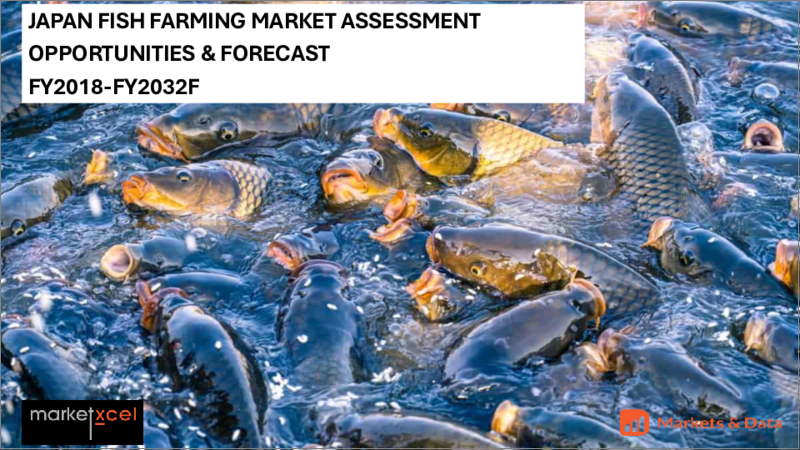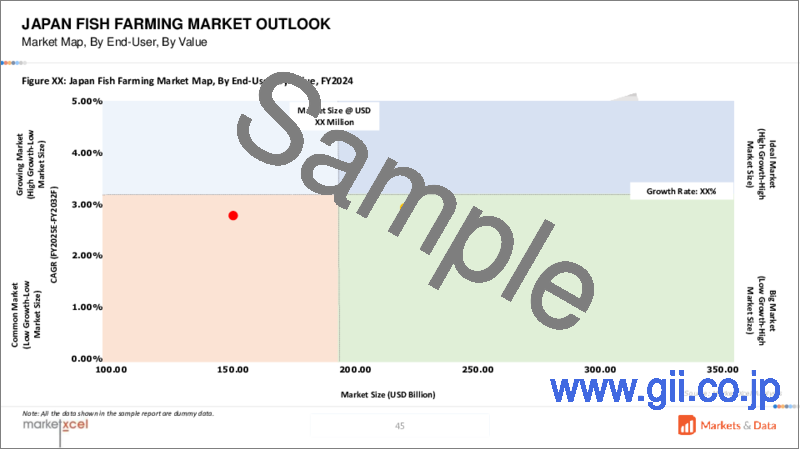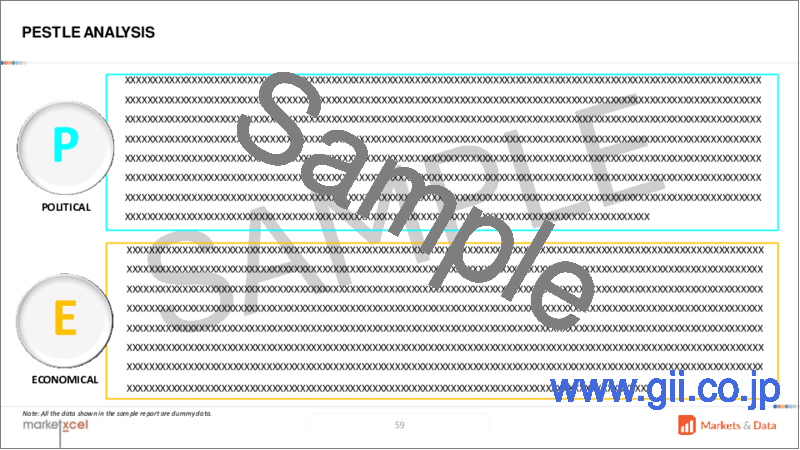|
|
市場調査レポート
商品コード
1556028
魚類養殖の日本市場の評価:種別、規模別、水源別、目的別、エンドユーザー別、流通チャネル別、地域別、機会、予測(2018年度~2032年度)Japan Fish Farming Market Assessment, By Species, By Scale, By Water Source, By Purpose, By End-user, By Distribution Channel, By Region, Opportunities and Forecast, FY2018-FY2032F |
||||||
カスタマイズ可能
|
|||||||
| 魚類養殖の日本市場の評価:種別、規模別、水源別、目的別、エンドユーザー別、流通チャネル別、地域別、機会、予測(2018年度~2032年度) |
|
出版日: 2024年09月17日
発行: Markets & Data
ページ情報: 英文 146 Pages
納期: 3~5営業日
|
全表示
- 概要
- 図表
- 目次
日本の魚類養殖の市場規模は、2024年度の56億5,000万米ドルから2032年度に66億7,000万米ドルに達すると予測され、2025年度~2032年度の予測期間にCAGRで2.10%の成長が見込まれます。日本は長い間、周辺の海洋資源に依存してきましたが、乱獲と環境の変化によって天然魚の個体数が大幅に減少しています。これに対処するため、日本は、天然魚資源を守りながら魚介類の需要を満たす持続可能な代替手段として魚類養殖にますます目を向けつつあります。Food and Agriculture Organizationの推計によると、2024年の日本の魚消費は5,842トンです。
技術の変化により、日本では陸上養殖がより実用的かつ効率的になっています。再循環養殖システムは、クローズドループシステムを通じて水を再利用するため、水質、温度、廃棄物管理を完全に管理することができ、その結果、魚を育てるためのあらゆる条件が最適化されます。このようなシステムは、スペースに対する高い需要と、環境への配慮に関する厳しい法律のため、日本で普及してきました。例えば2024年6月、日本の養殖企業であるSoul of Japan K.K.は、再循環養殖システム(RAS)施設を開発するため、2億1,100万米ドル(330億円)相当の長期借入枠を確保したと発表しました。この施設はアジア最大の陸上サーモン養殖場となり、年間1万トンのアトランティックサーモンを生産する予定です。
さらに、魚類養殖市場は、クローズドコンテインメントシステム、自動給餌、水質モニタリングによって拡大が見られます。こうした技術革新は効率を高め、環境に対する影響を低減し、魚の健康状態と成長条件のよりよい調整を可能にしています。また、スペースと天然資源の制約により、日本で重要な位置を占めています。
漁業は雇用を創出し、草の根レベルで経済を持続させることができるため、魚類養殖は、特に地方の沿岸地域にとって、多様化経済の1つとして日本政府によって支援されています。そのため、さまざまな地域開発戦略の不可欠な要素となっています。
市場の成長を促進する陸上養殖
陸上養殖は、日本で急速に発展している循環型養殖システムです。日本では、比較的狭い国土に人口が非常に密集しているため、伝統的な養殖と海洋漁業に大きな課題があります。その結果、沿岸海域では乱獲と汚染が進み、天然魚資源が減少し、魚を生産する代替方法が必要となっています。養殖は水質汚染や養殖種の野生への流出など、環境悪化のレベルが全体的に高いことから、陸上養殖はそれに代わるより実行可能で持続可能な方法です。
また、陸上養殖は、食料の品質と安全性が重視されるようになったことにより、国内でも人気が高まっています。養殖環境をよりコントロールすることで、生産者は疾患の心配がなく、日本の消費者が求める厳しい安全基準をすべて満たした高品質な魚を生産することができます。これは、日本の洗練された魚介類市場向けの高級魚の生産を可能にする方法です。
東京に本社を置くGeneral Oysterは2024年1月、世界で初めて陸上での牡蠣の養殖に成功したと発表しました。同社は、水温と水質が管理された屋内水槽を利用し、標準的な品質の魚を安定的に供給することを可能にしています。
増加する魚介類消費
日本では魚介類の需要が非常に高く、これが魚類養殖市場の成長を後押ししています。魚介類は日本料理の主食であり、寿司、刺身、天ぷらといった代表的な料理のベースとなっています。USDA Foreign Agricultural Serviceの推計によると、日本は世界有数の魚介類消費国であり、2022年に150億米ドルの魚介類輸入に寄与しています。
栄養豊富な海域に囲まれた日本の地理的環境は、長い間、魚介類を豊富かつアクセスしやすい食料供給としてきました。そのうえ、健康志向の消費者は、高品質なタンパク質やオメガ3系脂肪酸など、数多くの健康上の利点に関連する魚介類の栄養面での利点を高く評価しています。さらに、日本の漁業と魚介類市場には不可欠な産業的・市場的関連性があり、魚介類が日常消費と食文化の中心的構成要素であり続けることを保証しています。
当レポートでは、日本の魚類養殖市場について調査分析し、市場規模と予測、市場力学、主要企業の情勢と見通しなどを提供しています。
目次
第1章 プロジェクトの範囲と定義
第2章 調査手法
第3章 エグゼクティブサマリー
第4章 顧客の声
- 人口統計(年齢/コホート分析 - ベビーブーマー世代、X世代、ミレニアル世代、Z世代、性別、所得 - 低所得、中所得、高所得、地域など)
- 市場の認知度と製品情報
- ブランド認知度とロイヤルティ
- 購入決定において考慮される要素
- 購入頻度
- 購入媒体
- ブランドアンバサダーやインフルエンサーマーケティングが製品/ブランドの浸透に果たす役割
第5章 日本の魚類養殖市場の見通し(2018年度~2032年度)
- 市場規模の分析と予測
- 金額
- 数量
- 市場シェア分析と予測
- 種別
- 規模別
- 水源別
- 目的別
- エンドユーザー別
- 流通チャネル別
- 地域別
- 市場シェア分析:企業別(金額)(上位5社とその他 - 2024年度)
- 市場マップ分析(2024年度)
- 種別
- 規模別
- 水源別
- 目的別
- エンドユーザー別
- 流通チャネル別
- 地域別
第6章 需給分析
第7章 輸入と輸出の分析
第8章 バリューチェーン分析
第9章 ポーターのファイブフォース分析
第10章 PESTLE分析
第11章 マクロ経済指標
第12章 価格分析
第13章 利益率分析
第14章 市場力学
- 市場促進要因
- 市場の課題
第15章 市場の動向と発展
第16章 ケーススタディ
第17章 競合情勢
- マーケットリーダー上位5社の競合マトリクス
- 上位5社のSWOT分析
- 主要企業上位10社の情勢
- Maruha Nichiro Corporation
- Yama Seafood Inc.
- DAISUI CO., LTD
- DNI Group, LLC
- Seafood Legacy Co., Ltd.
- JGC Holdings Corporation
- Proximar Ltd
- Izumisawa-Suisan Co.Ltd.
- Nissui Corporation
- Mitsubishi Corporation (Toyo Reizo Co., Ltd.)
第18章 戦略的推奨
第19章 当社について、免責事項
List of Tables
- Table 1. Pricing Analysis of Products from Key Players
- Table 2. Competition Matrix of Top 5 Market Leaders
- Table 3. Mergers & Acquisitions/ Joint Ventures (If Applicable)
- Table 4. About Us - Regions and Countries Where We Have Executed Client Projects
List of Figures
- Figure 1. Japan Fish Farming Market, By Value, In USD Billion, FY2018-FY2032F
- Figure 2. Japan Fish Farming Market Share (%), By Species, FY2018-FY2032F
- Figure 3. Japan Fish Farming Market Share (%), By Scale, FY2018-FY2032F
- Figure 4. Japan Fish Farming Market Share (%), By Water Source, FY2018-FY2032F
- Figure 5. Japan Fish Farming Market Share (%), By Purpose, FY2018-FY2032F
- Figure 6. Japan Fish Farming Market Share (%), By End-user, FY2018-FY2032F
- Figure 7. Japan Fish Farming Market Share (%), By Distribution Channel, FY2018-FY2032F
- Figure 8. Japan Fish Farming Market Share (%), By Region, FY2018-FY2032F
- Figure 9. By Species Map-Market Size (USD Billion) & Growth Rate (%), FY2024
- Figure 10. By Scale Map-Market Size (USD Billion) & Growth Rate (%), FY2024
- Figure 11. By Water Source Map-Market Size (USD Billion) & Growth Rate (%), FY2024
- Figure 12. By Purpose Map-Market Size (USD Billion) & Growth Rate (%), FY2024
- Figure 13. By End-user Map-Market Size (USD Billion) & Growth Rate (%), FY2024
- Figure 14. By Distribution Channel Map-Market Size (USD Billion) & Growth Rate (%), FY2024
- Figure 15. By Region Map-Market Size (USD Billion) & Growth Rate (%), FY2024
Japan fish farming market is projected to witness a CAGR of 2.10% during the forecast period FY2025-FY2032, growing from USD 5.65 billion in FY2024 to USD 6.67 billion in FY2032. Japan has long relied on its surrounding marine resources, but overfishing and environmental changes have significantly declined wild fish populations. To address this, Japan is increasingly turning toward fish farming as a sustainable alternative to meet its seafood demand while preserving natural fish stocks. As per the estimates of the Food and Agriculture Organization, the fish consumption in Japan in 2024 was 5,842 tons.
The technological changes have made land-based aquaculture more practical and efficient in Japan. The recirculation aquaculture systems recycle the water through a closed-loop system, hence giving complete control over the quality of water, temperature, and waste management, consequently optimizing all the conditions for growing fish. Such systems have been prevalent in Japan due to the high demand for space and strict laws on environmental considerations. For instance, in June 2024, Soul of Japan K.K., a Japanese aquaculture company, announced that it had secured a long-term debt facility worth USD 211 million (JPY 33 billion) to develop a recirculating aquaculture system (RAS) facility. This facility will be Asia's largest land-based salmon farm and is expected to produce 10,000 tons of Atlantic Salmon annually.
Furthermore, the fish farming market is witnessing expansion due to closed containment systems, automated feeding, and water quality monitoring. These innovations are enhancing efficiency and reducing environmental impacts, allowing better regulation of fish health and growth conditions. It has been made significant in Japan due to space and natural resource constraints.
Fish farming is supported by the Government of Japan as one of the diversification economies, especially for rural coastal areas, since fishing industries are able to create jobs and sustain the economy at the grassroots level. It thus has become an integral component of various regional development strategies.
Land-based Fish Farming to Drive Market Growth
Land-based fish farming is a rapidly developing recirculating aquaculture system in Japan. The country has a very dense population on a relatively small land space, which presents significant challenges to traditional aquaculture and marine fisheries. It has resulted in overfishing and pollution in coastal waters, hence reducing wild fish stocks and necessitating alternative ways of producing fish. Land-based fish farming is a more viable or sustainable alternative to aquaculture since the levels of degradation of the environment, mainly water pollution and escape of farmed species to the wild, are generally high.
Besides, land-based fish farming is gaining popularity in the country due to the emphasis that has been laid on the quality and security of food. With more control over the farming environment, producers can produce high-quality fish that is disease-free and meets all the stringent safety standards required by Japanese consumers. It is a method that will allow the production of premium varieties of fish for Japan's sophisticated seafood market.
General Oyster, a Tokyo-based company, announced in January 2024 that it had successfully farmed oysters on the land for the very first time in the world. The company utilizes indoor tanks with controlled water temperature and quality, which enables a stable supply of fish of a standard quality.
Increasing Seafood Consumption
Japan has a massive demand for seafood, which is augmenting the growth of the fish farming market. Seafood is a staple in Japanese cuisine, forming the base of iconic dishes such as sushi, sashimi, and tempura. According to the USDA Foreign Agricultural Service estimates, Japan is one of the world's leading seafood consumers, contributing to the imports of USD 15 billion of seafood products in 2022.
Japan's geographical surroundings, bounded by nutrient-rich waters, have long made seafood an abundant and accessible food supply. Besides, health-conscious consumers appreciate the nutritional advantages of seafood, such as high-quality protein and omega-3 fatty acids, which are associated with numerous health benefits. Moreover, there is an essential industrial and market relevance to the fishing industry and seafood markets in Japan, guaranteeing seafood remains a central component of daily consumption and culinary culture.
Salmon to Dominate Market Share in Japan
Salmon is consumed in a high quantity in Japan due to cultural preference, health benefits derived from its consumption, and market dynamics. Salmon fish consumption in Japan has been fueled by the advancement of freezing and farming techniques, which have made it a lot safer for consumption.
The richness and flavor in taste, further assisted by all-round culinary usage, have made salmon popular. It is widely used in sushi, sashimi, and other dishes in Japanese cuisine, finding favor with a huge range of consumers. Besides, health imperatives ascribed to salmon, such as high omega-3 fatty acid content, falling in line with health-conscious Japanese consumer trends, further drive the consumption of this fish variety. Other factors, such as consistency of supply and reasonable and relatively stable prices, make salmon more favored than other kinds of fish.
In May 2024, Proximar Ltd, a Japanese land-based salmon farmer, expected to harvest its first Atlantic Salmon in September 2024. Proximar operates its first production facility at the foot of Mount Fuji in Japan. The company targets an annual production of 5,300 tons in Phase 1, with a gradual increase following the initial harvest.
Future Market Scenario (FY2025 - FY2032F)
The market is expected to witness expansion in the fish farming market due to the regulation of the standards of fish farming by global regulatory bodies such as the Aquaculture Stewardship Council. The regulations help fish farmers promote the best environmental and social fish farming, which fulfills the sustainability requirements. For instance, in June 2024, a Japanese fish farm, Izumisawa-Suisan Co.Ltd., became the first commercial farm to obtain Aquaculture Stewardship Council (ASC) certification for its cherry salmon production. The farm, which produces coho salmon, is based in Kamaishi City.
Key Players Landscape and Outlook
The increased key players' investments and multinational companies in the fish farming market in Japan, along with the introduction of innovative products, are driving the market growth exponentially. The growth is fueled by the entry of new players into the emerging market and existing products.
As land-based fish farming is gaining wide popularity in Japan, the key players are expanding their operations and initiating business in land-based or off-shore fish farming. For instance, in May 2022, JGC Holdings Corporation announced that its subsidiary, JGC Japan Corporation, a domestic EPC business company, has been awarded a contract to form a new company, Kamome Mirai Fisheries Company, to develop technology and demonstrate production in the field of onshore aquaculture together with building associated sales channels.
Table of Contents
1. Project Scope and Definitions
2. Research Methodology
3. Executive Summary
4. Voice of Customer
- 4.1. Demographics (Age/Cohort Analysis - Baby Boomers and Gen X, Millennials, Gen Z; Gender; Income - Low, Mid and High; Geography; etc.)
- 4.2. Market Awareness and Product Information
- 4.3. Brand Awareness and Loyalty
- 4.4. Factors Considered in Purchase Decisions
- 4.4.1. Quality
- 4.4.2. Ease in Availability
- 4.4.3. Price
- 4.4.4. Versatility in Application
- 4.4.5. Peer Group Influence
- 4.5. Frequency of Purchase
- 4.6. Medium of Purchase
- 4.7. Role of Brand Ambassador or Influencer Marketing on Product/Brand Absorption
5. Japan Fish Farming Market Outlook, FY2018-FY2032F
- 5.1. Market Size Analysis & Forecast
- 5.1.1. By Value
- 5.1.2. By Volume
- 5.2. Market Share Analysis & Forecast
- 5.2.1. By Species
- 5.2.1.1. Freshwater Fish Farming
- 5.2.1.1.1. Koi/Carp
- 5.2.1.1.2. Mabuna/Kinbuna (Japanese Silver Crucian Carp)
- 5.2.1.1.3. Others
- 5.2.1.2. Saltwater Fish Farming
- 5.2.1.2.1. Salmon
- 5.2.1.2.2. Japanese Yellowtail
- 5.2.1.2.3. Amberjack
- 5.2.1.2.4. Red Seabream
- 5.2.1.2.5. Others
- 5.2.1.3. Brackish Water Fish Farming
- 5.2.1.3.1. Japanese Rice Fish (Medaka)
- 5.2.1.3.2. Mullet
- 5.2.1.3.3. Others
- 5.2.1.1. Freshwater Fish Farming
- 5.2.2. By Scale
- 5.2.2.1. Small Scale Fish Farming
- 5.2.2.2. Medium Scale Fish Farming
- 5.2.2.3. Large Scale Fish Farming
- 5.2.3. By Water Source
- 5.2.3.1. Freshwater
- 5.2.3.1.1. Rivers
- 5.2.3.1.2. Lakes
- 5.2.3.1.3. Reservoirs
- 5.2.3.2. Saltwater
- 5.2.3.2.1. Oceans
- 5.2.3.2.2. Seas
- 5.2.3.3. Brackish Water
- 5.2.3.3.1. Mangroves
- 5.2.3.3.2. Estuaries
- 5.2.3.1. Freshwater
- 5.2.4. By Purpose
- 5.2.4.1. Food Fish Farming
- 5.2.4.2. Ornamental Fish Farming
- 5.2.4.3. Others
- 5.2.5. By End-user
- 5.2.5.1. Residential
- 5.2.5.2. Commercial
- 5.2.6. By Distribution Channel
- 5.2.6.1. Offline
- 5.2.6.1.1. Direct B2B Sales
- 5.2.6.1.2. Supermarkets and Hypermarkets
- 5.2.6.1.3. Specialty Stores
- 5.2.6.1.4. Others
- 5.2.6.2. Online
- 5.2.6.2.1. E-commerce Websites
- 5.2.6.2.2. Company Owned Websites
- 5.2.6.1. Offline
- 5.2.7. By Region
- 5.2.7.1. North [Hokkaido and Tohoku]
- 5.2.7.2. Central [Kanto and Chubu]
- 5.2.7.3. South [Kansai, Chugoku, Shikoku, Kyushu, Okinawa]
- 5.2.8. By Company Market Share Analysis (Top 5 Companies and Others - By Value, FY2024)
- 5.2.1. By Species
- 5.3. Market Map Analysis, FY2024
- 5.3.1. By Species
- 5.3.2. By Scale
- 5.3.3. By Water Source
- 5.3.4. By Purpose
- 5.3.5. By End-user
- 5.3.6. By Distribution Channel
- 5.3.7. By Region
All segments will be provided for all regions covered
6. Demand Supply Analysis
7. Import and Export Analysis
8. Value Chain Analysis
9. Porter's Five Forces Analysis
10. PESTLE Analysis
11. Macro-economic Indicators
12. Pricing Analysis
13. Profit Margin Analysis
14. Market Dynamics
- 14.1. Market Drivers
- 14.2. Market Challenges
15. Market Trends and Developments
16. Case Studies
17. Competitive Landscape
- 17.1. Competition Matrix of Top 5 Market Leaders
- 17.2. SWOT Analysis for Top 5 Players
- 17.3. Key Players Landscape for Top 10 Market Players
- 17.3.1. Maruha Nichiro Corporation
- 17.3.1.1. Company Details
- 17.3.1.2. Key Management Personnel
- 17.3.1.3. Products and Services
- 17.3.1.4. Financials (As Reported)
- 17.3.1.5. Key Market Focus and Geographical Presence
- 17.3.1.6. Recent Developments/Collaborations/Partnerships/Mergers and Acquisition
- 17.3.2. Yama Seafood Inc.
- 17.3.3. DAISUI CO., LTD
- 17.3.4. DNI Group, LLC
- 17.3.5. Seafood Legacy Co., Ltd.
- 17.3.6. JGC Holdings Corporation
- 17.3.7. Proximar Ltd
- 17.3.8. Izumisawa-Suisan Co.Ltd.
- 17.3.9. Nissui Corporation
- 17.3.10. Mitsubishi Corporation (Toyo Reizo Co., Ltd.)
- 17.3.1. Maruha Nichiro Corporation
Companies mentioned above DO NOT hold any order as per market share and can be changed as per information available during research work.





